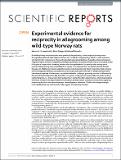Files in this item
Experimental evidence for reciprocity in allogrooming among wild-type Norway rats
Item metadata
| dc.contributor.author | Schweinfurth, Manon K. | |
| dc.contributor.author | Stieger, Binia | |
| dc.contributor.author | Taborsky, Michael | |
| dc.date.accessioned | 2019-04-15T09:30:01Z | |
| dc.date.available | 2019-04-15T09:30:01Z | |
| dc.date.issued | 2017-06-21 | |
| dc.identifier | 258579499 | |
| dc.identifier | 8954af99-d52a-4c08-b9b8-5d8bd79368c5 | |
| dc.identifier | 85021210225 | |
| dc.identifier.citation | Schweinfurth , M K , Stieger , B & Taborsky , M 2017 , ' Experimental evidence for reciprocity in allogrooming among wild-type Norway rats ' , Scientific Reports , vol. 7 , 4010 . https://doi.org/10.1038/s41598-017-03841-3 | en |
| dc.identifier.issn | 2045-2322 | |
| dc.identifier.other | ORCID: /0000-0003-2066-7892/work/56639212 | |
| dc.identifier.uri | https://hdl.handle.net/10023/17521 | |
| dc.description | Funding was provided by SNF-grant 31003A_156152 to Michael Taborsky. | en |
| dc.description.abstract | If individuals help more those who have previously helped them, stable cooperation may ensue through alternation of roles between donors and recipients. Allogrooming, which is costly to donors and beneficial to recipients, is often exchanged between social partners. Arguably, allogrooming and allopreening are the most frequently exchanged social services and have been used as a standard model of reciprocal cooperation. However, evidence for the application of reciprocity rules among social partners allogrooming each other hitherto is merely correlational. Here, we tested whether female Norway rats (Rattus norvegicus) apply the decision rule characterising direct reciprocity: help someone who has helped you before, by experimentally manipulating both the need for allogrooming and the behavioural response. Furthermore, we checked whether trading of grooming services is influenced by the rank of the social partner. We show that rats groom social partners reciprocally and prefer to do so up the hierarchy, i.e. they groom dominant partners more often than subordinates, while reciprocating with both. This provides experimental evidence that animals render a costly social service by applying reciprocity decision rules when showing a natural hygienic behaviour. The fact that allogrooming is more readily shown up the hierarchy may suggest an appeasing function. | |
| dc.format.extent | 8 | |
| dc.format.extent | 1363409 | |
| dc.language.iso | eng | |
| dc.relation.ispartof | Scientific Reports | en |
| dc.subject | BF Psychology | en |
| dc.subject | NDAS | en |
| dc.subject | BDC | en |
| dc.subject.lcc | BF | en |
| dc.title | Experimental evidence for reciprocity in allogrooming among wild-type Norway rats | en |
| dc.type | Journal article | en |
| dc.contributor.institution | University of St Andrews. School of Psychology and Neuroscience | en |
| dc.identifier.doi | 10.1038/s41598-017-03841-3 | |
| dc.description.status | Peer reviewed | en |
This item appears in the following Collection(s)
Items in the St Andrews Research Repository are protected by copyright, with all rights reserved, unless otherwise indicated.

